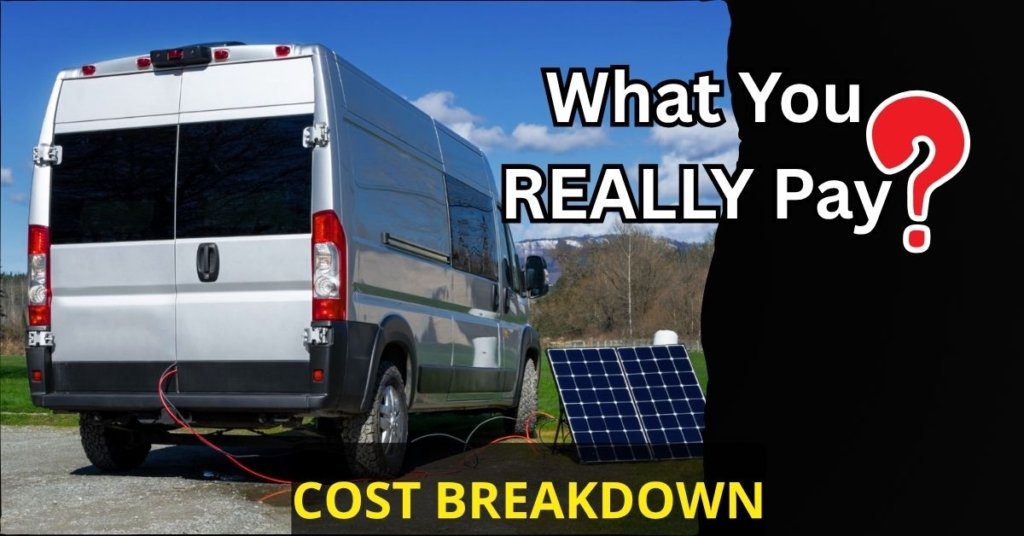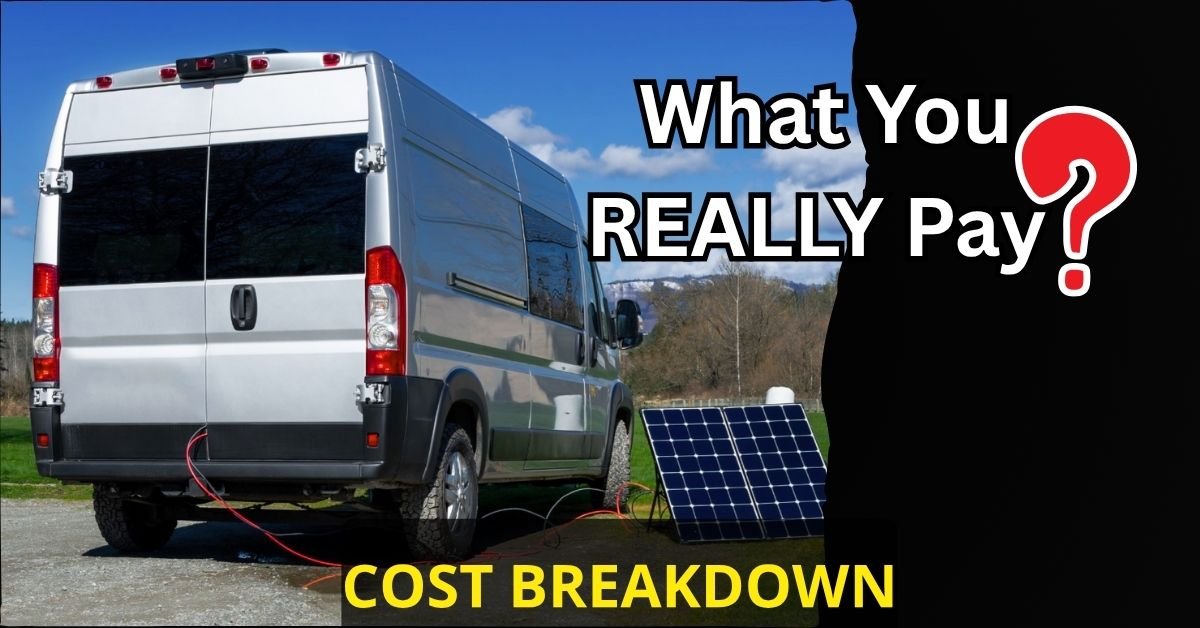Dreaming of Solar… But Dreading the Bill? Let’s Break Down Every Dollar—From Panels to Hookups—So You Can Budget Accurately for Van Solar Cost Accurately..
The open road, endless adventure, and the freedom to power your van life wherever you roam – it all sounds incredible, right? Solar panels make that dream a reality, offering self-sufficiency and a significantly reduced carbon footprint. But before you dive in, understanding the true “van solar cost” is crucial. It’s not just about the panels themselves; there’s a whole ecosystem of components and labor that contributes to the final price tag.
Let’s pull back the curtain and reveal what you really pay for solar power in your mobile home.

Panel & Kit Price Ranges
When it comes to solar panels for your van, you’ll find a spectrum of options, largely categorized by their power output, brand reputation, and whether they come as a complete kit or individual components.
1. Budget-Friendly Options (Often Individual Panels or Basic Kits):
For those looking to get started without breaking the bank, individual rigid or flexible panels can range from $100 – $300 per 100W panel. Basic kits, often including a single panel, charge controller, and some wiring, might start around $250 – $600. These are great for minimal power needs or as a supplementary source.
2. Mid-Range Kits (Common for Most Van Lifers):
This is where most van builders land. These kits typically include multiple panels (200W-400W total), a quality MPPT charge controller, an inverter, necessary cabling, and mounting hardware. Prices for these comprehensive kits usually fall between $800 – $2,000. They offer a good balance of power, efficiency, and value.
3. Premium Brands & High-Output Systems:
If you’re planning on running high-draw appliances like air conditioning or induction cooktops, you’ll need a more robust system. Premium brands like Renogy, Battle Born, or Victron Energy offer highly efficient panels, advanced charge controllers, and powerful inverters. These systems can range from $2,500 to $5,000+, depending on the total wattage and battery bank size. They often boast superior durability, efficiency, and smart monitoring features.
Example: The Renogy 400W 12V Premium Solar Kit costs around $1,099, offering efficient monocrystalline panels, MPPT controller, and full install gear—ideal for full-time van dwellers.
Accessories & Materials
The panels are just one part of the equation. You’ll need a host of other components to make your solar system functional and safe. Don’t overlook these essential costs:
- Charge Controller: This crucial device regulates the power flowing from your panels to your batteries. MPPT (Maximum Power Point Tracking) controllers are highly recommended for their efficiency, typically costing $100 – $400. PWM (Pulse Width Modulation) controllers are cheaper ($30 – $100) but less efficient.
- Inverter: To power your AC appliances (laptops, blenders, etc.), you’ll need an inverter to convert DC power from your batteries to AC. Prices vary greatly by wattage, from $150 for a basic 500W inverter to $800+ for a powerful 3000W pure sine wave inverter.
- Batteries: This is often the most significant investment after the panels themselves. Lithium Iron Phosphate (LiFePO4) batteries are the gold standard for van life due to their longevity, light weight, and deep discharge capabilities, costing $500 – $2,000+ per 100Ah battery. Traditional lead-acid batteries are cheaper but heavier and have a shorter lifespan.
- Wiring & Fuses: Proper gauge wiring, fuses, circuit breakers, and bus bars are essential for safety and efficiency. Budget $100 – $300 for these critical components.
- Mounting Hardware: Brackets, roof glands, and sealants to securely attach your panels to your van’s roof will cost around $50 – $150.
- Monitoring System: Many modern systems include Bluetooth or display monitors to track power usage, battery state of charge, and solar input. These can be integrated into your charge controller or purchased separately for $50 – $200.
DIY vs. Pro Installation Costs
This is where your personal skills and comfort level can significantly impact your overall “van solar cost.”
- DIY Installation: If you’re handy and willing to invest the time in learning electrical basics (safety first!), going DIY can save you a significant amount on labor. Your costs will primarily be for the components mentioned above. Many van lifers successfully install their own systems with the help of online tutorials and communities.
- Professional Installation: Hiring a professional to install your solar system offers peace of mind and ensures everything is done correctly and safely. However, this comes at a premium. Expect labor costs to range from $500 to $2,000+, depending on the complexity of your system and the installer’s rates. For a complete, integrated system, some installations can even push $3,000 – $5,000 for labor alone. This is often the choice for those who aren’t comfortable with electrical work or prefer a warrantied installation.
Ongoing Maintenance & Replacement
While solar systems are generally low-maintenance, they aren’t entirely set-it-and-forget-it. Budget for:
- Cleaning: Regularly cleaning your panels (especially after dusty roads or pollen season) ensures maximum efficiency. This is usually a DIY task.
- Component Checks: Periodically check wiring for corrosion, ensure connections are tight, and monitor battery health.
- Battery Replacement: While LiFePO4 batteries can last 10-15 years or more, other battery types have shorter lifespans. Factor in potential battery replacement costs every 3-7 years for lead-acid batteries.
- Inverter/Charge Controller Replacement: These components can last for many years, but like any electronic device, they can fail. Budget for potential replacements every 5-10 years, costing anywhere from $100 – $800+.
Cost-Saving Tips & Incentives
Reducing your “van solar cost” isn’t just about finding cheap components; it’s also about smart planning and leveraging available programs.
- Optimize Your Energy Needs: Before buying, make a detailed list of every appliance you want to run and how long. You might find you don’t need as large or expensive a system as you initially thought.
- Buy Integrated Kits: Often, purchasing a complete solar kit from a reputable brand can be more cost-effective than buying individual components, as they are designed to work together seamlessly.
- Shop Sales & Used Market: Keep an eye out for sales from major solar retailers. You might also find good deals on gently used panels or components from other van lifers upgrading their systems. Always exercise caution and verify the condition if buying used.
- Federal Solar Tax Credit (Residential Clean Energy Credit): While primarily for home solar, if your van is considered your primary residence and meets specific criteria, you might be eligible for the federal solar tax credit (currently 30% for systems installed through 2032). Consult with a tax professional to see if your specific situation qualifies. This can significantly reduce your net cost.
- EV-Van Solar Rebates/Incentives: Some states or local utilities may offer incentives for converting vehicles to electric or for installing renewable energy systems, even if they’re mobile. Research programs in your home state or where you plan to register your van. These are less common for direct “solar van” conversions but worth investigating.
Learn Van Solar Panel Installation: A Step-by-Step Guide.
Conclusion,
Understanding the full scope of “van solar cost” means fewer surprises down the road—and more freedom to truly enjoy your mobile lifestyle. While the initial investment might seem substantial, the long-term benefits of self-sufficient power and reduced reliance on shore power are immeasurable for many van lifers.
👉 Ready to price it out? Browse current van solar kits on Amazon and see what fits your adventure budget.







